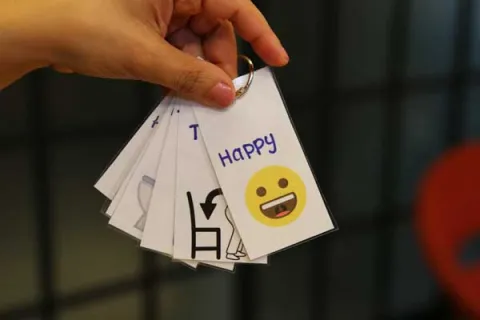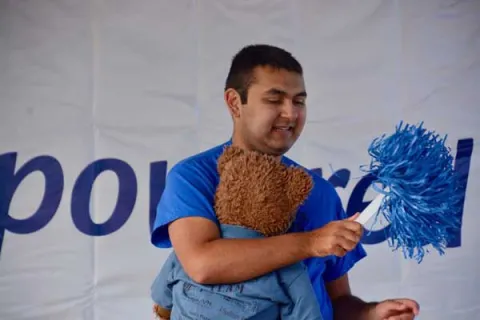Our son with autism loves trains so much he won’t get off
By behavior analyst Sungwoo KahngSungwoo Kahng, of the University of Missouri’s Thompson Center for Autism and Neurodevelopmental Disorders, is a behavior analyst. The Thompson Center is one of 13 sites in the Autism Speaks Autism Treatment Network (ATN).
Our son’s love for trains has become a problem because he doesn’t want to come out of the train when we reach the destination. If we take him off by force, we have to face a 10 to 15 minute tantrum in the train stations.
As you probably know, restricted interests are among the characteristics of autism spectrum disorder. Often, we see this as repetitive behaviors, insistence on sameness and/or a difficulty transitioning from a favorite activity – such as your son’s love for being on a train.
It’s important to remember that most people – on or off the autism spectrum – devote a lot of time to their special interests. For example, I enjoy playing tennis a couple times a week. When I’m not on the court, I occasionally read tennis-related news articles and watch online videos on how to, say, hit a better forehand. However, I can generally shift my attention to participate in other activities.
When special interests become inflexible
By contrast, many children – and adults – who have autism need considerable help expanding their interests and learning how to shift their attention away from a favorite activity.
Before we discuss strategies – ideally in the context of a behavioral therapy program – I want to explain why helping your son develop varied interests is so important.
First, your son’s inability to disengage from his special interest is certainly causing significant problems for your family. But it’s also likely interfering with his social development and learning. For example, varied interests are important for having an enjoyable conversation and simply playing with others. Similarly, he needs to be able to transition from one activity to another in school – even if he’s in a special classroom for students who have autism.
It’s also very common – and understandable – for caregivers to inadvertently reinforce the problematic intensity and inflexibility of a special interest. No doubt, it gives your family joy to see your son enjoy a train ride. Perhaps you’ve even given him toy trains and enjoyed picture books around trains. Certainly there are appropriate ways to allow your son to enjoy his special passion – just as we all should have a chance to enjoy our favorite activities. However, we want to avoid increasing your son’s inflexibility to other activities.
Strategies that can help
So now to the helpful strategies. As mentioned above, I’m hoping your son has access to professional services such as behavioral therapy. If so, I encourage you to work together with the therapist and your son’s teachers to tailor an intervention to his personal needs. That’s something I can’t do from a distance.
I can offer two approaches that we often use with success at our autism center. Ideally, any behavioral intervention will incorporate both methods.
The first method focuses on increasing the variety of the activities that your son enjoys. One way to do this involves temporarily limiting the activity that’s creating problems – long enough to promote some new interests.
In your son’s case, this would mean temporarily limiting how often you take him on trains or indulge in other train-related activities such as watching trains and reading about trains. I appreciate that, in the short term, this can place a burden on your whole family if you depend on trains to travel together.
Introducing a new activity
During this pause from trains and train-related activities, it’s important to encourage interest in other activities. Be sure to praise and reward any interest he shows, no matter how small.
As for selecting some new activities, you know your son best. Try to recall something he enjoyed that wasn’t train related. In my experience, most children with autism have other interests. But their level of enthusiasm or attention may seem modest. So look carefully for these sparks of interest.
By way of example, let’s say you noticed your son briefly watching children feed ducks at your neighborhood park. You take him to the duck pond and encourage him to feed the birds. Perhaps he responds by pouting and turning away. But then he looks in the ducks’ direction. Immediately reward that spark of interest with praise and perhaps a little treat (small toy or favorite snack). Next, you might encourage him to look at the duck food in your hand … then watch you feed the ducks. Remember to praise and reward each small step toward his involvement in the new activity.
Be sure to give your son lots of opportunities to try out these alternative activities and keep providing praise and reward at each small sign of progress.
Building patience
Another approach – which you can use at the same time – is to help your son learn to tolerate having to wait for his favorite activity. Given that trains run on schedules, I suggest doing this when you do NOT have a specific train to catch.
For instance, perhaps you could plan a trip to your local train station. You might explain to your son that together you will practice standing in the waiting room before going out on the platform to see the trains come and go.
We want to encourage success. So it’s best to start with very short waits. Let’s say 10 seconds before praising your son for waiting and immediately going out to watch the trains. Very gradually increase the amount of time your son must wait (e.g., 15 seconds, 30 seconds, 45 seconds, 1 minute and so on). But don’t try to do it all on one day. And of course, praise and reward your son for his efforts. Remember, it’s very important that you build up tolerance in a very gradual manner.
Similarly, you might try this “waiting” approach at home with a favorite video about trains.
Visual supports for waiting
Many children – and adults – affected by autism respond best to visual cues. So consider using a visual support to help your son gauge the amount of time he needs to wait or how long he can indulge in a favorite activity. This can be as simple as a watch with a second hand and a pair of cards – one red for “wait” and one green for “go.” Show or hand your son the card to cue him.
Similarly, you might use the red and green cards to encourage your son to talk about something other than trains. Hand him the green card to signal it’s okay to talk about trains. Hand him the red card when it’s time to talk about something else.
Remember, you don’t want to deny your son his special passion. So be sure to schedule times in the day when he can indulge in train-related books, videos or toys.
Time to get off that train
You mentioned, in particular, the struggles you’ve had getting your son to get off the train on arrival. Again, practice is vital to your son’s success. You can continue using the visual supports such as the red/green card. Flip it to red when it’s time to disembark. Even better, give him a five-minute warning before arrival. You can use both verbal cues (“Five minutes till we get off.”) and a visual support such as a yellow card.
In the same manner, you can practice transitioning away from train-related games and videos at home. Always make sure he gets lots of praise and rewards for this transition.
I want to emphasize that this is not a quick fix. It will take a lot of practice to help your son vary his activities and learn to transition away from his favorite activity – that is, getting off the train.
I encourage you to get creative in arranging situations where he can practice trying new activities and building up tolerance to the need to transition away from the activity.
Related resources
- Why do autistic people like trains?
- ATN/AIR-P Introduction to Behavioral Health Treatments Tool Kit
- ATN/AIR-P Visual Supports and Autism Tool Kit
Editor’s note: The above information is not meant to diagnose or treat and should not take the place of personal consultation, as appropriate, with a qualified healthcare professional and/or behavioral therapist.











